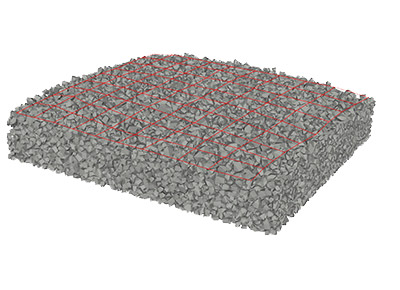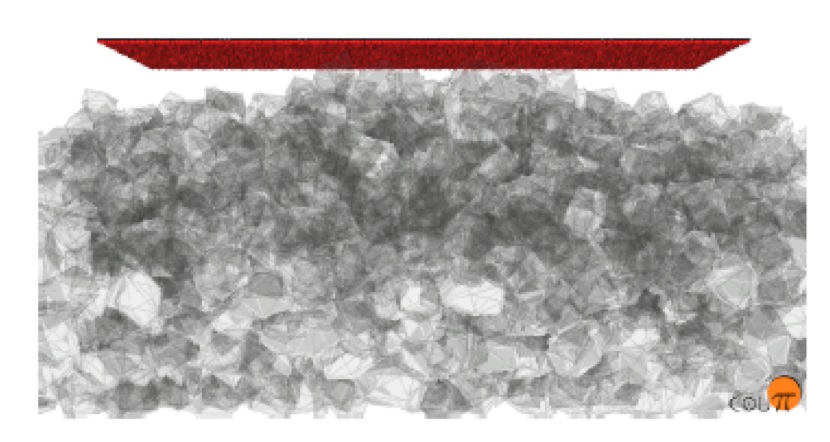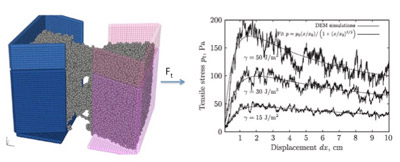Solar Wind Implantation into Lunar Soil
As part of the VORTICES effort to understand the Moon’s water cycle, the Coupi DEM is used to study the penetration depth of solar wind particles into the lunar soil.
Efforts to find water on the moon have been ongoing since ice was predicted to exist in permanently shadowed craters at the lunar poles more than 50 years ago. Water is important as it plays a fundamental role in planetary evolution and is a resource needed for any long-term human habitation.
The existence of ice at the lunar polar regions was only confirmed in 2009, resulting in a shift in science priority from finding water on the moon to understanding the processes by which water forms and migrates within and out of the lunar soil. Solar wind hydrogen penetrating the lunar soil and interacting with soil particle surface materials are a favored explanation of the observed variations of water and hydroxyl distribution on the Moon.
A Coupi DEM model simulating solar wind bombardment of the lunar soil at the soil grain scale is used to determine how the distribution of soil particle size, shape, and porosity affect the depth of penetration of solar wind particles into the lunar soil. Knowing the depth of hydrogen penetration is critical to understanding the molecular interactions that control the production and stability of water under bombardment by the solar wind. Understanding the physical processes of water formation and migration in the lunar soil at the grain scale provides input to global scale models to improve their accuracy in describing the global production and migration of water on the moon.

Figure 1: DEM particle size distribution for lunar soil simulant and the DEM representation of the lunar soil using angular particles showing the zero level surface grid.

Figure 2: Close up view of the semi-transparent angular DEM particles representing lunar soil particles showing the plane of hydrogen particles above the particle bed prior to the simulation.

Figure 3: The distribution of hydrogen within the particle bed after the simulation of hydrogen particle bombardment of lunar soil.
Hydrogen particles are placed above the bed of angular DEM particles representing lunar soil prior to the simulation. A velocity is applied to the hydrogen particles such that they impinge the particle bed at different angles to simulate solar wind particle impact with lunar soil. Simulation results are used to determine the rate of hydrogen implantation into lunar soil as a function of depth and impingement angle for different mean soil porosities. Hydrogen particles travel deeper into the soil as grain size and porosity is increased, providing a source of volatiles in the upper layer of soil. Future work will focus on describing the molecular interactions of hydrogen with surface materials to determine the production, migration and distribution of water and other hydrogen based volatiles in the lunar soil.
Figure 4: Hydrogen implantation rate as a function of impingement angle for soil porosities of 0.52 and 0.53. Depth is normalized by the mean particle size, D.
Additional information about lunar soil and simulating angular particle shapes can be found in:
Kulchitsky, A. V., D. M. Hurley, J. B. Johnson, and P. Duvoy. “Effect of Porosity on Access of Solar Wind to Lunar Regolith.” In Lunar and Planetary Science Conference, vol. 46, p. 2649. 2015. Nye, B., Kulchitsky, A. V. and Johnson, J. B. (2014), Intersecting dilated convex polyhedra method for modeling complex particles in discrete element method. Int. J. Numer. Anal. Meth. Geomech., 38: 978–990. doi: 10.1002/nag.2299 VORTICES – Volatile Regolith Thermal Investigations Consortium for exploration & Science. Zeng, X., He, C., Oravec, H., Wilkinson, A., Agui, J., & Asnani, V. (2009). Geotechnical properties of JSC-1A lunar soil simulant. Journal of Aerospace Engineering, 23(2), 111-116.

